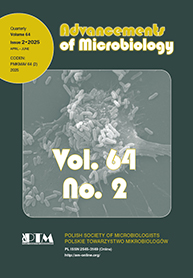Drożdże jako potencjalne źródło tłuszczu mikrobiologicznego
1. Wstęp. 2. Mikroorganizmy olejogenne. 3. Enzymatyczne drogi syntezy tłuszczu w komórkach drożdży. 3.1. Biosynteza tłuszczu de novo. 3.2. Biosynteza tłuszczu ex novo. 4. Czynniki wpływające na proces biosyntezy tłuszczu. 5. Próby doskonalenia genetycznego drożdży olejogennych. 6. Ekstrakcja tłuszczu z komórek drożdży. 7. Możliwości przemysłowego zastosowania tłuszczu mikrobiologicznego. 8. Podsumowanie
Abstract: The yeast which can produce more than 20% lipids in their dry matter are called oleaginous and belong mainly to the genera Yarrowia, Rhodotorula, Rhodosporidium, Cryptococcus, Trichosporon and Lipomyces. The synthesis and storage of fat in yeast cells can be achieved via two pathways. In the first method – de novo, the acetyl-CoA and malonyl-CoA molecules are substrates of the lipid for the synthesis, while in the ex novo method, the hydrophobic compounds present in the environment are utilized. The process of lipid biosynthesis in yeast cells is affected by environmental factors such as carbon and nitrogen source in the medium, the C/N molar ratio, pH, temperature and the time of the cultivation. Microbial synthesis as the type of fat production process has many advantages, since it is insusceptible to weather conditions and the season of the year. Moreover, yeast show a rapid growth rate, which significantly shortens the production cycle. The main drawback of the industrial SCO production is low fat yield per unit of culture medium, which increases the total cost of the project. Microbiological fat synthesized by yeast might be used as a substitute for vegetable oils in human nutrition or as a substrate for the production of biodiesel.
1. Introduction. 2. Oleaginous microorganisms. 3. Enzymatic synthesis pathways of fat in yeast cells. 3.1. De novo lipid accumulation. 3.2. Ex novo lipid accumulation. 4. Factors affecting the biosynthesis of fat. 5. Attempts to genetically improve oleaginous yeast. 6. Extraction of fat from yeast cells. 7. Industrial applicability of microbial fat. 8. Conclusions

